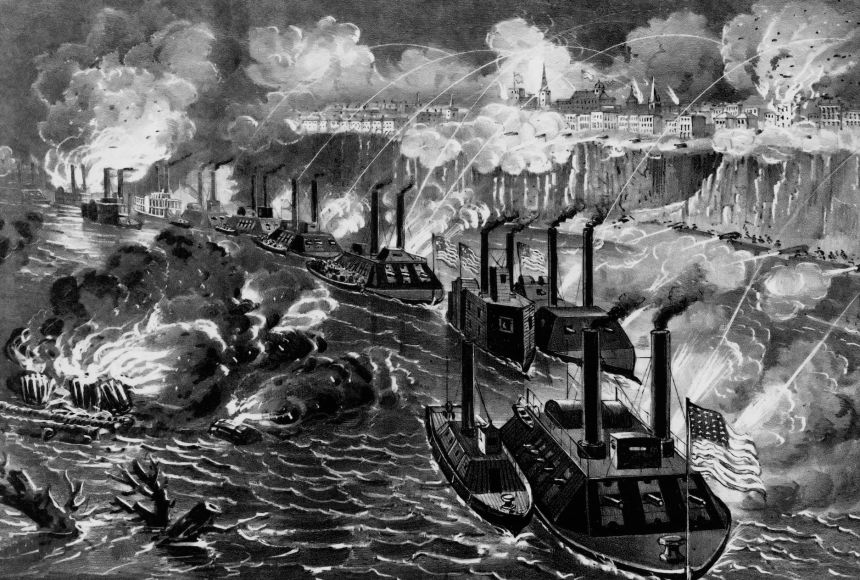The United States Civil War was the bloodiest war in U.S. history. More than 50 major battles were fought between the Union, made up of northern states, and the Confederacy, made up of southern states. The Confederate states seceded from the United States in 1861. The Civil War lasted four years. Below are five of the most significant battles.
First Bull Run (July 21, 1861)
The first Battle of Bull Run was the first major land battle of the Civil War. It is also known as the first Battle of Manassas.
The battle began after the Union Army under General Irvin McDonnell marched from Washington, D.C., with plans to seize the Confederate capital of Richmond, Virginia. About 42 kilometers (25 miles) into the march, their path was blocked by the Confederate Army. Confederate forces were under the command of General P.G.T. Beauregard.
At first, it seemed as if the Union Army would win. However, as the battle raged throughout the morning, the Confederates held their ground. Once the Confederates received reinforcements early that afternoon, they counterattacked. They quickly defeated Union forces, who retreated to Washington, D.C.
Combined casualties were few compared with other battles, but were still around 4,800.
Shiloh (April 6–7, 1862)
By February 1862, the Union Army had achieved victories in Kentucky and Tennessee. It then set out to gain control of an important Confederate railway line in northern Mississippi. To defend the line, Confederate General Albert Sidney Johnston massed his forces in the town of Corinth, Mississippi. The Union planned to unite two armies and then take Corinth. One Union brigade was under the command of Ulysses S. Grant, and the other was led by Don Carlos Buell.
Grant's army arrived first and set up camp in the town of Pittsburg Landing, Tennessee, near the Shiloh Meeting House. Johnston wanted to strike Grant's army before Buell arrived, and at dawn on April 6, Johnston's forces attacked. Grant's Union men were surprised but remained in the field after a day of fierce fighting. Buell's forces finally arrived overnight, and the combined Union forces attacked at dawn. During the fighting, General Johnston was killed. Confederate forces were defeated and withdrew.
The battle resulted in combined casualties of more than 23,000 people.
Antietam (September 17, 1862)
Confederate General Robert E. Lee had decided to take the war to the North. He came up with a plan to split his army and take supplies in Maryland, move into Pennsylvania and threaten Washington, D.C. His plans accidentally fell into Union hands, and the Union Army marched to meet Lee's forces at Antietam Creek in Maryland. However, Union General McClellan waited 18 hours before moving his troops. This gave the Confederates time to bring in reinforcements.
The day of fighting ended in a draw, with 23,000 men killed. However, the battle halted Lee's plans to invade the North for the time being.
Gettysburg (July 1-3, 1863)
Antietam was a setback to Lee's plans. However, the Union failed to take advantage of the situation. Union forces lost quite badly at Fredericksburg, Virginia (December 13, 1862), and Chancellorsville, Virginia (April 30–May 4, 1863).
These Confederate victories encouraged Lee to once again attempt to invade the North. Lee moved the Army of Northern Virginia north. His forces were met by Union troops at the town of Gettysburg, Pennsylvania, on the morning of the first of July. Union forces were under the command of General George Meade.
The Confederates had the upper hand at first, but the Union Army held on and kept them from advancing. The following day, reinforcements arrived for both sides, and Lee again failed to defeat the Union Army.
The third of July saw one last push from the Confederates. Lee ordered an assault by 15,000 Confederate troops up Cemetery Ridge. This attack later became known as Pickett's Charge. Although the charge broke through Union lines, the Confederates were unable to hold on to their gains and soon retreated.
Lee's forces withdrew on the fourth of July, and the Union Army did not pursue them.
Union casualties numbered around 23,000, while Confederate casualties numbered around 28,000.
Vicksburg (May 22–July 4, 1863)
Vicksburg, Mississippi, is located midway along the vitally important Mississippi River. Capturing it would give control of the entire Mississippi to the Union. However, the city was heavily defended with trenches, gun batteries, and a Confederate Army led by General John C. Pemberton.
In May, Union forces commanded by General Ulysses S. Grant attacked Vicksburg and quickly surrounded the city. By mid-June, Confederate forces trapped inside Vicksburg were running low on supplies. General Pemberton surrendered on the fourth of July.
The Union victories at Gettysburg and Vicksburg, which came just a day apart, marked the turning point of the Civil War.
These are just some of the major battles in a war that killed hundreds of thousands. Today, many Civil War battlefield sites contain monuments and plaques and have been set aside as national parks.

